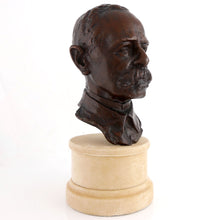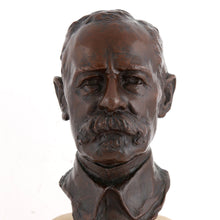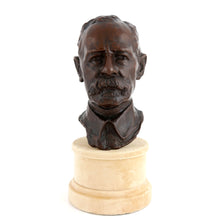Portrait Head of FM Frederick Sleigh Roberts, VC, KG, 1900
- Regular price
- £1,250
- Sale price
- £1,250
- Regular price
-
- Unit price
- /per
Adding product to your cart
Height of bronze: 15cm (6in)
Bronze. Portrait head of ‘Bobs’ (1832-1914). Attributed to Sydney March (1876-1968), possibly as an alternative likeness to his standing figure of Lord Roberts that formed part of Elkington’s popular series celebrating British commanders in Boer War (1899-1902). Mounted on a modern turned base. The bronze signed and dated ‘Elkington & Co. Ltd, Copyright 1900’. Height overall: 21cm (8.5in).
In 1900 Roberts was already widely known and admired public figure. Known for his gallantry in the Indian Mutiny (1857-58) during which he won the Victoria Cross, and more recently for his famous forced march from Cabul to the relief of British forces at Kandahar during the Second Afghan War (1878-1880), Roberts was Commander-in-Chief, India before taking command of British Forces in the Second Boer War. The present bust was perhaps produced in acknowledgment of his march of 480 km from Bloemfontein to Pretoria.
Read more
Starting with with 38,000 troops on 3 May 1900, only 26,000 entered Pretoria. Some had been left to garrison Johannesburg or dropped off to act as guards, about 3,000 were battle casualties, some had been lost through disease and other causes, but a high proportion were dismounted cavalrymen or mounted infantry left behind because their horses had died or were exhausted.
The march was accomplished on short rations and in trying weather conditions in 34 days, including halts totalling 16 days. While it achieved the decisive result which had been anticipated, Botha's peace proposals and the surrender of the Boer capital of the South African Republic (Transvaal), it also gave the Boers breathing space in which to regroup and restore morale. Thereafter they determined to continue their struggle by means of guerrilla warfare. Roberts, meanwhile, returned to England, was made a Knight of the Garter and created Earl Roberts of Kandahar in Afghanistan and Pretoria in the Transvaal Colony and of the City of Waterford and Viscount St Pierre.










